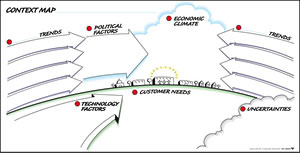 David Sibbett, in his excellent new book, Visual Meetings: How Graphics, Sticky Notes & Idea Mapping Can Transform Group Productivity, shares a number of tips and strategies for sharing key charts, maps and diagrams with meeting participants. Doing so helps them to retain the information discussed (a concept called “group memory”) and what they agreed to during the meeting. It also provides a sense of continuity from one meeting to the next.
David Sibbett, in his excellent new book, Visual Meetings: How Graphics, Sticky Notes & Idea Mapping Can Transform Group Productivity, shares a number of tips and strategies for sharing key charts, maps and diagrams with meeting participants. Doing so helps them to retain the information discussed (a concept called “group memory”) and what they agreed to during the meeting. It also provides a sense of continuity from one meeting to the next.
In the book, Sibbett shares a number of ways of sharing these visual outputs with others in print and digitally. While he is talking mainly about hand-drawn charts, diagrams and visual maps, these strategies also apply to mind maps used to capture the ideas and decisions from meetings:
In print
- Simple photocopies of key charts and diagrams
- Full color digital prints that capture the diagrams in a larger-sized format, such as 11 x 17 inches
- Annotated reports, in which you add titles and captions to charts to create a chronology of the meeting
- Picture books, in which you add images and explanatory text to the charts to tell the full story of the meeting
Online sharing
- Photograph the key charts, diagrams and maps generated during the meeting, process them to reduce their size and resolution to reduce their file sizes and then e-mail them to the meeting participants as JPG images. Sibbett says this is fast and easy way to communicate a quick post-meeting summary to all of the meeting participants.
- Combine key charts and diagrams in a PDF document
- Insert JPG images of key charts and diagrams into a PowerPoint presentation, add captions to them and share them with meeting participants via e-mail
- Post images in an online site that everyone can access; be sure to create smaller and larger versions of each chart, so participants can view thumbnail images of each diagram, but also click on them to view a larger, higher-resolution version
- Upload large files to a secure file sharing website (such as box.net) and then provide meeting participants with its URL and user names and passwords where they can download them.
- Reference key charts and diagrams in web meetings – in other words, share the results of the meeting via web conference, and display the visual outputs of the meeting on screen
Other tips for sharing visual materials
- Format your charts and diagrams so that they can be divided into easily readable sections. Don’t overwhelm them with a massive mind map in which the outermost topics are formatted in 5 point type that is barely readable without a magnifying glass!
- If you’re sharing your meeting output online, be sure to leverage the ability to link your meeting participants and others with additional resources. For example, you can format regions of images with “hot spots” so that when someone clicks on them, their web browser opens a specific web page. This enables people to view a high-level presentation of your meeting’s output, while others who want more detail can easily “drill down” into supporting documents and resources. Smart! Another option, enabled by newer types of graphic software, is to embed “popovers” that display ancillary information if you mouse over a specific region of your diagram.
Isn’t this a lot of work? Yes, but it’s a worthwhile investment in the future effectiveness of the team: “It does take time to do all this, but having the material in visual form is part of what supports productivity and group memory over time,” Sibbett acknowledges.
Help people understand the context
One critical point that really resonated with me is this: The charts and diagrams you’re sharing mean a lot to the people who participated, because they can look at these visuals and understand the meaning and context behind them. However, if you plan to share the visual output of your meeting with others who were not in your meeting, they lack this context.
To overcome this challenge, Sibbett offers a very clever solution: Produce a report in which diagrams and their text explanations are formatted on facing pages. “That way you get the best of both text-based and graphic representations,” he explains.
I think this is a simply brilliant solution to a very common problem.
If you’re wondering what the world looks like beyond mind mapping, Sibbett’s book is an excellent guide to visual thinking techniques. Why not pick up a copy of Visual Meetings today?

Leave a Reply